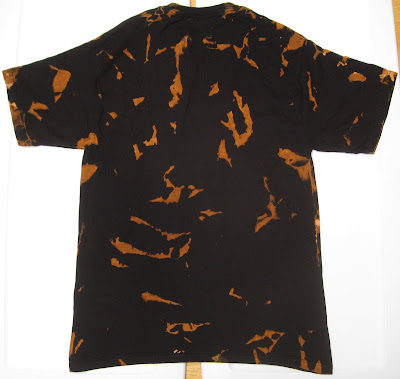My latest effort has been trying out discharge dyeing on black shirts. This was pretty successful in my dyeing class, but I didn't get a chance to do it myself on the black shirts. So now that the class is over, it's my turn!
I took several black shirts of various sizes and brands (or at least models) and did them the way I'm used to doing shirts: in my favorite tie-dye patterns. I did a couple in the spiral tie (one as a "spiral", the other as "rays" or "sunburst"), one in my favorite V pattern, a crinkle, and one shibori-style just smooshed up (technical term) diagonally and tied.
I experimented a bit with the thickness of the Soft Scrub With Bleach. I was mostly using up the partially-filled squeeze bottles of Soft Scrub that I had left over from my class--I hate to waste anything, but it was time to start reclaiming my squeeze bottles.
Here is the "rays" shirt. I coated it thickly on one side.
 On the other side, I added a little water to what was left in the bottle, shook it up, and squirted that over the whole second side. Note the little blobs of thicker Soft Scrub in places.
On the other side, I added a little water to what was left in the bottle, shook it up, and squirted that over the whole second side. Note the little blobs of thicker Soft Scrub in places.
Here is the "rays" shirt with the thickly-coated side. Note the bright lines.

Here is the side coated with diluted Soft Scrub.

For the crinkle shirt, I coated one side in a thin layer of Soft Scrub by rubbing it in the puddle of drips from a different shirt (no waste!). Then I emptied another small squirt bottle onto it to make the web of white lines you see here:
 Here is the side where I put the extra lines of thicker Soft Scrub. You can see brighter spots within the darker orange sections.
Here is the side where I put the extra lines of thicker Soft Scrub. You can see brighter spots within the darker orange sections. The second side has a more uniform effect.
The second side has a more uniform effect.
This is the "spirals" shirt. I did thick layers on both sides, but I did not do the two narrow stripes on the other side.
 With narrow stripes:
With narrow stripes: and without:
and without:
I put on thick bands of Soft Scrub on both sides of the folded V shirt.

Here is the first side of the V shirt.

And here is the second side. Not exactly what I had expected, but I had expected the Soft Scrub to penetrate more than just the single layer. It hardly penetrates at all beyond the first layer (just enough to make it look like a mistake).

For the "smooshed" shirt, I tied it pretty loosely, and pretty much used it to mop up all the remaining Soft Scrub dribbles on my table.

Here is the result. It had a thin layer of Soft Scrub, so it didn't bleach very strongly. Interestingly, though, it bleached to almost a heathery orange-grey, not to orange like the other shirts. Both this and the crinkle shirt are Fruit of the Loom Lofteez shirts, though the crinkle is a Medium and the other is a Small.


The shibori shirt just got more of the same:

 And I did something similar for the crinkle to give it more depth, though it ended up quite different from front to back.
And I did something similar for the crinkle to give it more depth, though it ended up quite different from front to back.  Front:
Front:






























 Now I'm starting to put the bricks on with a natural sponge. I mix colors right on the sponge. A little water helps to blend the colors more.
Now I'm starting to put the bricks on with a natural sponge. I mix colors right on the sponge. A little water helps to blend the colors more.
 Time to light the fire...
Time to light the fire... A couple hours later, it's looking good enough to call it "done"--of course, now that I'm looking at the photo, I see things I want to go back and fix! ("Sara, step AWAY from the paints!")
A couple hours later, it's looking good enough to call it "done"--of course, now that I'm looking at the photo, I see things I want to go back and fix! ("Sara, step AWAY from the paints!") Now I've put back the real fireplace screen we've had there for years. The whole thing took me somewhere between 8 and 10 hours. This is for my father-in-law's house, and now I'm thinking my house needs one too. Of course, first I'd have to FIND our fireplace! It's behind some huge shelves full of kids' craft supplies. Maybe another time...
Now I've put back the real fireplace screen we've had there for years. The whole thing took me somewhere between 8 and 10 hours. This is for my father-in-law's house, and now I'm thinking my house needs one too. Of course, first I'd have to FIND our fireplace! It's behind some huge shelves full of kids' craft supplies. Maybe another time...
